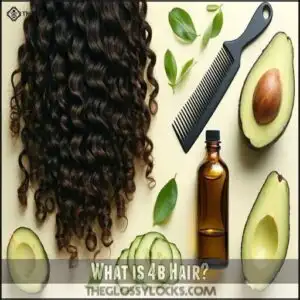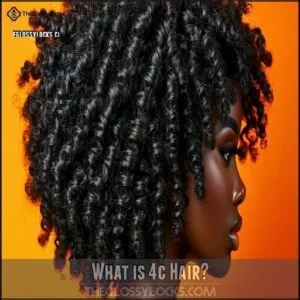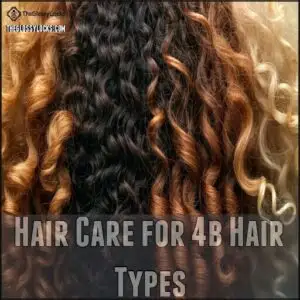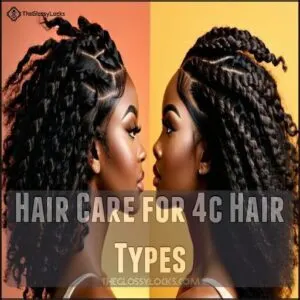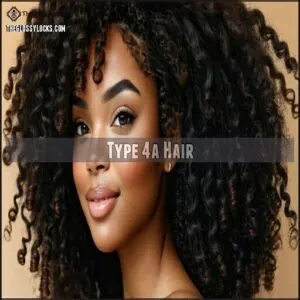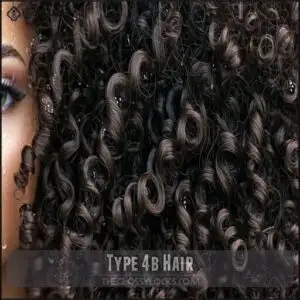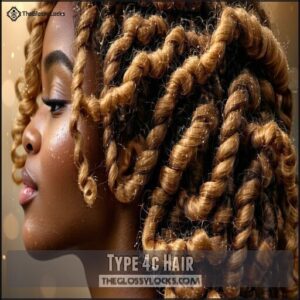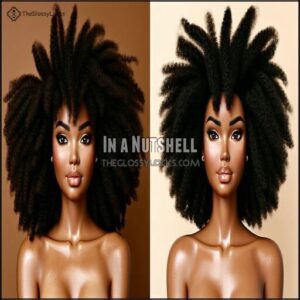This site is supported by our readers. We may earn a commission, at no cost to you, if you purchase through links.
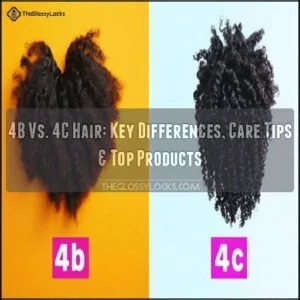
4b hair has a tighter zig-zag pattern that’s more defined, almost like the loops took a sharp turn.
4c hair, on the other hand, has super tight curls that are less defined and can shrink up to 75% of their length (talk about a magic trick).
Both types are prone to dryness and need plenty of moisture, but 4c may need extra TLC since it tangles more easily.
Whether you’re styling or caring for these beautiful textures, knowing the difference helps you embrace your curls fully and pick the right products.
Table Of Contents
- Key Takeaways
- Distinguishing 4b and 4c Hair
- Hair Care Tips for Type 4 Curls
- Using Products for Natural Hair & Curls
- Type 4a Hair
- Type 4b Hair
- Type 4c Hair
- In a Nutshell
- Frequently Asked Questions (FAQs)
- How do I know if my hair is 4b or 4c?
- Is 4b better than 4c?
- Are 4b and 4c the same?
- What are the benefits of using avocado for natural hair?
- What is the best way to determine my hair type?
- What protective styles are recommended for type 4 hair?
- What are the differences between 4b and 4c hair?
- How often should I wash my type 4 hair?
- How does porosity affect 4b and 4c care?
- What styles work best for 4b-4c hair?
- Conclusion
Key Takeaways
- 4b hair has a zigzag pattern, while 4c hair has tighter, less defined coils with significant shrinkage.
- Both types need regular moisture; 4c hair requires extra hydration due to its fragility and tendency to tangle.
- Use protective styles like twists or braids to minimize breakage and maintain length for both hair types.
- The LOC method (liquid, oil, cream) works well to keep hair hydrated and enhance curl definition.
Distinguishing 4b and 4c Hair
You might think 4B and 4C hair look the same at first, but their curl patterns and care needs are surprisingly different.
Understanding the unique characteristics of each can help you care for your hair more effectively, which involves recognizing that complete concepts of hair care are crucial for effective hair management.
What is 4b Hair?
4B hair stands out with a unique zigzag or “Z” pattern that doesn’t form visible curls.
4B hair shines with its striking zigzag pattern, embodying versatility and beauty while embracing the power of proper moisture and care.
Its texture can range from soft and fine to thick and wiry, making it one of the most versatile curly hair types.
Unlike looser curl patterns, 4B struggles with natural oil distribution, which can lead to dryness.
That’s where natural moisturizers like avocado or castor oil become game changers for maintaining 4B moisture.
When styling 4B, gentle techniques are key—think finger detangling or wide-tooth combs.
The easiest way to define 4B hair? Look closely at the strands: they resemble sharply bent zigs rather than rounded curls.
With the right care, this coily hair type thrives beautifully.
What is 4c Hair?
4c hair, the tightest coil pattern in the hair typing system, features densely packed, zigzag strands that may appear cottony or silky, depending on texture and products.
4C hair’s tight coils create a crown of beauty, thriving with hydration and care to reveal its stunning, versatile texture.
One key 4C characteristic is shrinkage, as strands can shrink up to 80% of their actual length.
Despite its beauty, 4c hair presents challenges like dryness and fragility since natural oils struggle to travel down the coily strand.
A common 4C misconception is that it’s unmanageable, but with the right care, it thrives!
Focus on moisturizing with shea butter, coconut oil, and leave-in conditioners.
Protective styles, low manipulation, and sulfate-free shampoos also promote hair health and length retention.
Hair Care Tips for Type 4 Curls
Caring for Type 4 curls means keeping them moisturized and reducing breakage with the right techniques.
Whether you’re managing 4B’s zigzag strands or 4C’s tight coils, consistent hydration and gentle handling are key.
Hair Care for 4b Hair Types
When caring for 4b hair, moisture is your best friend. Regular hydration combats 4b shrinkage and dryness, so apply the LOC method: start with water or leave-in conditioner, seal with oils (like coconut), and finish with a creamy moisturizer.
For 4b detangling, use wide-tooth combs or finger-comb gently to prevent 4b breakage. Hydrating serums are essential for maintaining moisture.
Styles like twists or braids protect your strands while keeping them manageable. To reduce damage, wash in sections and use sulfate-free shampoos. With consistent care, 4b styling can be easier, helping you retain length and embrace your hair’s beautiful zigzag curl pattern.
Hair Care for 4c Hair Types
4C hair thrives with high-moisture care and gentle handling to counter shrinkage. Prioritize hydration and minimize product buildup for healthy, defined curls.
Here’s how to keep 4C curls happy:
- Stay hydrated: Use water-based moisturizers or hydration-rich hair products daily.
- Shrinkage solutions: Stretch hair with banding or twists to maintain length.
- Protective styling: Try braids or buns to shield ends and reduce breakage.
- Gentle detangling: Finger-comb or use a wide-tooth comb with conditioner.
- Deep condition weekly: Tackle dryness with masks packed with natural oils.
With care, 4C hair stays vibrant and strong! Many find success using a specific 4C moisturizer for best results.
Using Products for Natural Hair & Curls
Choosing the right hair products for your natural curls is key to healthy, vibrant strands.
For 4b and 4c hair, focus on moisture retention and damage prevention. Look for products with hydrating ingredients like shea butter, coconut oil, and aloe vera.
Sulfate-free shampoos gently cleanse without stripping natural oils, while deep conditioners boost moisture and curl definition. When applying products, use the LOC method—liquid, oil, cream—to lock in hydration.
Lightweight oils like jojoba and argan are great for sealing and adding shine. Finding the right products for 4b hair can substantially improve hair health.
For product application, work in sections to guarantee even coverage and tangle-free results. Always finger-detangle or use a wide-tooth comb to prevent breakage.
With the right routine, your curls will bounce with life!
Type 4a Hair
Type 4a hair stands out with its tightly coiled, S-shaped pattern and notable shrinkage. It’s softer, more defined, and easier to manage than 4b and 4c hair.
Proper moisture is key to keeping these coils healthy and bouncy.
- Hydrate with oils like avocado or coconut to enhance 4a moisture and curl definition.
- Use shampoos designed for natural textures and section hair to avoid tangles.
- Deep condition weekly for shine and strength.
- Protective styles, like twists, minimize breakage and maintain your 4a elegance.
Type 4b Hair
Unlike 4a’s defined curls, 4b hair flaunts a tight zigzag curl pattern that’s soft, fluffy, or coarse.
This hair type thrives on moisture—regular pre-shampoo treatments with oils like avocado or olive help tackle dryness.
Detangling with wide-tooth combs and styling in protective looks such as twists preserve its delicate strands.
Skip heat tools when possible; they weaken the texture over time.
Quick fixes? Leave-in conditioners boost 4b moisture instantly, keeping your natural beauty shining effortlessly every day.
Hydrating serums are essential for this hair type, and remembering your curls, your rules is key to maintaining healthy hair, with the help of hydrating serums.
Type 4c Hair
4c hair is all about tight, coily magic, but it needs extra love to thrive.
Its shrinkage can reach over 70%, so stretch your curls after washing to show off length.
Keep breakage at bay by finger-combing damp strands and deep conditioning weekly.
Hydration is essential—think oils like coconut or castor and leave-in conditioners.
Since oil struggles to reach the ends, prioritize moisture to fight dryness.
Protective styles and minimal heat keep your kinky hair healthy and stunning every day.
In a Nutshell
Understanding your hair type, whether it’s 4b or 4c, is key to creating a routine that works.
These hair types have unique curl patterns and moisture retention needs, so knowing what sets them apart is half the battle.
Here’s a quick guide to managing and loving your texture:
- Use oils like avocado or coconut to improve moisture retention and combat dryness.
- Try protective styles like twists or braids to reduce breakage and give your curls a rest.
- Finger comb instead of brushing to avoid frizz and minimize damage.
- Stretch your hair when wet to manage shrinkage and show off length.
- Examine wet strands in good light to better identify your curl patterns and hair porosity.
With the right care, your 4b and 4c curls can thrive!
Frequently Asked Questions (FAQs)
How do I know if my hair is 4b or 4c?
Think of your hair like a unique fingerprint.
If your strands zigzag like sharp angles, it’s likely 4B.
If your curls are tighter, springy, and shrink drastically, you’ve got 4C.
Is 4b better than 4c?
Neither 4B nor 4C hair is “better.”
They’re just different.
4B has more defined curls and slightly easier manageability, while 4C requires extra care due to tighter coils.
Both are beautifully unique in their own way!
Are 4b and 4c the same?
It’s like comparing cousins—similar but unique.
While 4B has tight zigzag strands, 4C forms even tighter, less defined coils.
Both shine with proper care, but 4C often needs extra moisture due to its fragility.
What are the benefits of using avocado for natural hair?
Avocado works wonders for natural hair.
It’s packed with healthy fats, vitamins, and minerals that boost moisture, strengthen strands, and reduce breakage.
Plus, its creamy texture makes it a natural, budget-friendly conditioner.
What is the best way to determine my hair type?
Determining your hair type isn’t rocket science but does require patience.
Examine your curl pattern, strand size, and texture when wet and dry.
Compare with Andre Walker or LOIS systems for accurate results.
What protective styles are recommended for type 4 hair?
Try box braids, twists, or Bantu knots to shield your hair while keeping it stylish.
Cornrows or updos work great too.
Choose protective styles that minimize tension, reduce breakage, and let your scalp breathe!
What are the differences between 4b and 4c hair?
Did you know 4C hair shrinks up to 75%, while 4B only shrinks slightly less?
4B forms zigzag strands with a bit more definition, while 4C’s tighter, fragile coils lack a distinct curl pattern.
How often should I wash my type 4 hair?
Wash your type 4 hair every 1-2 weeks to maintain moisture without stripping natural oils.
Overwashing dries it out, so focus on conditioning and using sulfate-free shampoos.
Listen to your hair—it knows what it needs!
How does porosity affect 4b and 4c care?
Porosity impacts how your hair retains moisture.
Low-porosity hair resists absorption, needing lightweight products, while high-porosity hair easily loses moisture, requiring heavier creams or oils.
Adjust treatments based on how quickly your hair absorbs water, using heavier creams or oils as needed.
What styles work best for 4b-4c hair?
Protective styles like twists, braids, or bantu knots balance elegance and ease, minimizing breakage while nourishing strands.
Add flair with beads or scarves.
Stretch your shrinkage, embrace your texture, and let your hair tell its story!
Conclusion
Understanding the difference between 4b vs 4c hair is key to embracing your natural texture.
With its zig-zag pattern, 4b hair is more defined, while 4c hair’s tighter curls and high shrinkage need extra moisture and care.
Both types thrive with hydrating products and gentle handling.
Finding the right routine helps reduce tangles and enhance your curls’ definition.
Celebrate your unique texture, invest in quality products, and show your curls the love they deserve for healthy, stunning results.

